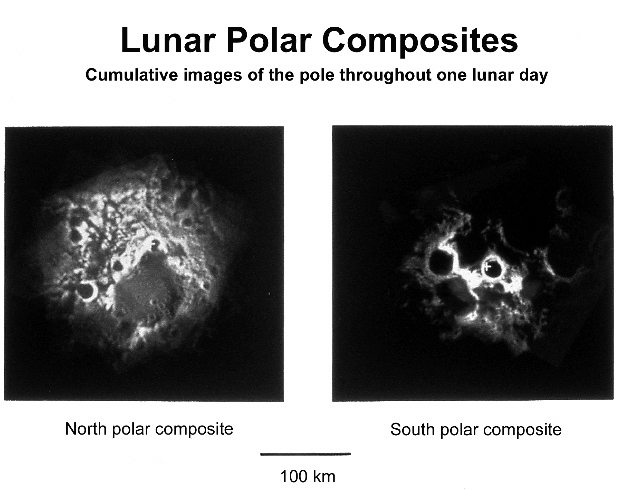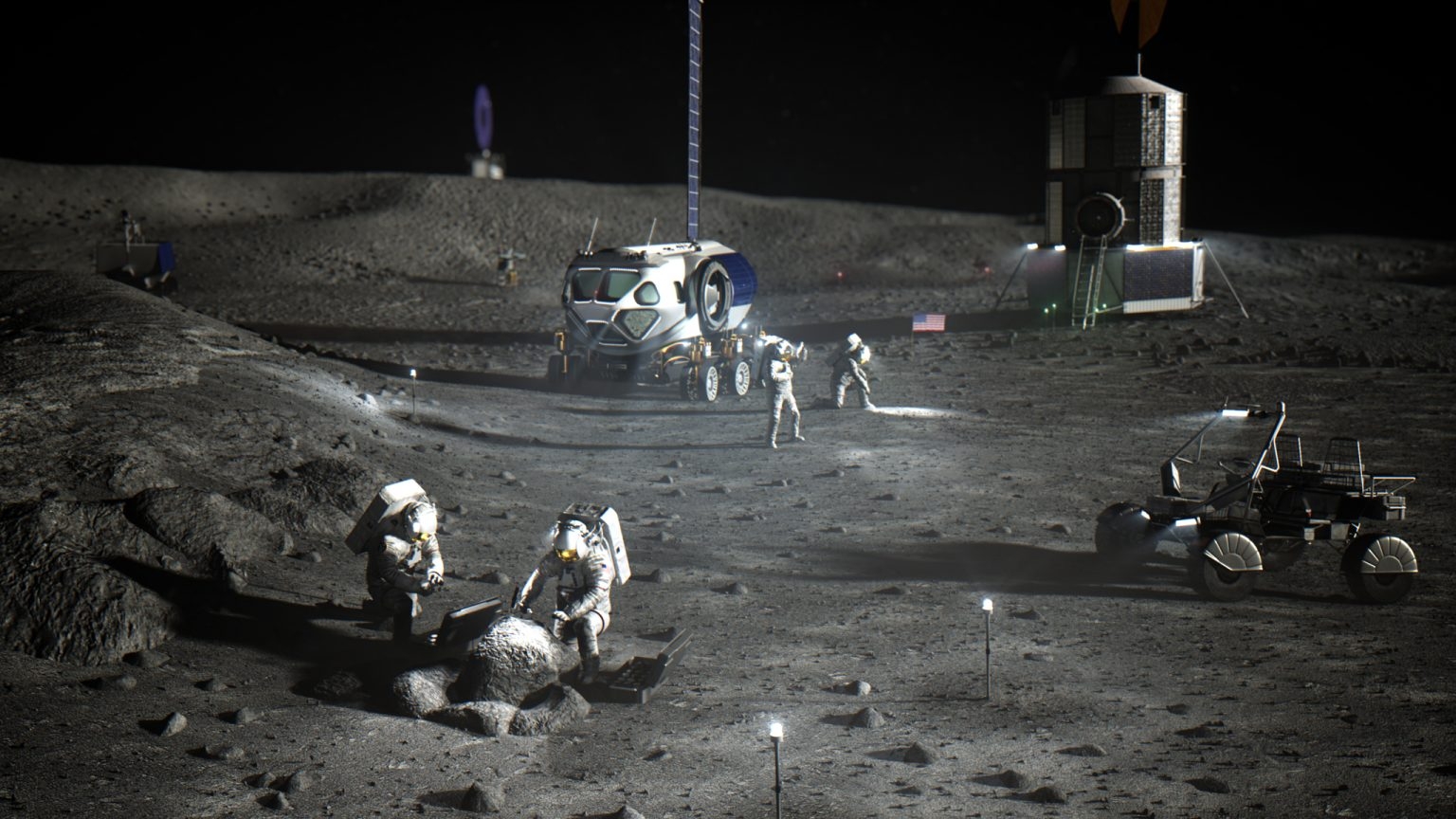Moon Water: A Trickle of Data and a Flood of Questions

NASA is in the process of scripting how best to plant new bootprints on the Moon and take advantage of lunar resources that could prolong human stays on that barren ball of rock.
While the Moon is one desolate world, it could turn out to be a faraway faucet of sorts.
Robotic spacecraft--both the Pentagon's Clementine (1994) and NASA's Lunar Prospector (1998-1999) missions--point to the promise that the Moon is a literal watering hole for crews.
Permanently shadowed craters at the lunar poles, called "cold traps," might be repositories of water ice. More importantly, this reserve could be converted to oxygen, drinkable water, even rocket fuel.
However, water ice on the Moon is far from being a slam dunk deduction. There is ongoing dispute about whether or not such frozen caches of water reside in sunshine-deprived lunar craters.
NASA's Lunar Reconnaissance Orbiter in 2008 will dive into the issue. Future robotic Moon landers are expected to plop down at polar regions for a spot check too. In the interim, space lawyers are at the ready to voice legal opinions on tapping into any water ice found.
Unique illumination conditions
Breaking space news, the latest updates on rocket launches, skywatching events and more!
There is "intriguing evidence" that, potentially, water ice on the Moon exists in fairly significant amounts, said Ben Bussey, a lunar expert at the John Hopkins University Applied Physics Laboratory (APL) in Laurel, Maryland.
NASA's Lunar Prospector clearly identified an enhanced signal of hydrogen--an indication that nobody has any qualms with, Bussey told SPACE.com. "But there's the argument ... is it hydrogen or is the hydrogen in a form of water ice?"
The Pentagon's Clementine lunar orbiter yielded data that, some scientists contend, gave a positive indication for ice inside Shackleton crater, situated at the Moon's south pole.
Yet there is controversy about that interpretation, Bussey noted, adding that Earth-based radar of that area, some argue, reflect more a signal of rocks and not ice.
"The [lunar] poles represent the biggest unknowns," Bussey said, leaving the scientific community hungry for new information. "We definitely know that the poles have unique illumination conditions with the potential for permanent sunshine. We know that there's lots of permanent shadow which could contain ice."
In the big scheme of things, looking for ice does not, in itself, merit going back to the Moon.
"But if it's there ... and it is there in enough quantity to be extractable and usable, then I can see there's a potential where you want to use it. It makes your life easier," Bussey said. On the other hand, he questioned, if it is there, is it in a form that makes it viable to be used?
Cometary frost
Apollo 17 moonwalker and geologist Harrison Schmitt questions the availability of water ice at the lunar poles.
For one, NASA's Lunar Prospector detected what must be largely solar wind hydrogen, Schmitt told SPACE.com. The only areas where water ice might be contributing to that signal are places where permanent shadowing exists near the poles, he said.
"Indeed, cometary volatiles--including water ice--probably precipitate as frost in permanent shadow at the lunar poles," Schmitt said, something that has been shown theoretically by a number of researchers. The longevity of this frost, however, is subject to the rate of micrometeorite and solar wind erosion, he noted.
"Unless the cometary frost, including water ice, is buried quickly by fortuitous impact ejecta or is partially protected in a very deep crater with permanent shadow, it will probably disappear in a geologically short time," Schmitt advised.
No doubt, finding cometary frosts in deep, permanently shadowed craters will be scientifically very interesting, the moonwalker said. "However, I would not yet count on finding economically significant water ice deposits."
Schmitt said that potentially substantial amounts of solar wind hydrogen are present everywhere on the Moon along with helium-4, helium-3, carbon and nitrogen. Hydrogen and helium concentrations are clearly higher in polar regions independent of whether there is cometary water ice.
"So those of us interested in lunar helium-3 fusion power are very interested in more precise mapping of hydrogen distribution as a surrogate for helium-3. We hope that the Lunar Reconnaissance Orbiter will provide such information," Schmitt said.
Touch the water
The prospect of finding water ice at the Moon's poles is indeed arguable, said Larry Taylor, Director of the Planetary Geosciences Institute at the Department of Earth & Planetary Sciences at the University of Tennessee in Knoxville.
Taylor, like other lunar experts, said it's imperative that we "touch the water." Doing so is the only way to know if water ice is there in the first place. And if truly present and accounted for, then other questions follow: How much, what quality, and how hard to process?
"The only way to solve this major question" of water ice on the Moon, Taylor emphasized, is not from orbit.
"There does not appear to be any instruments that are completely definitive, even from 'near' remote sensing, such as on a simple lander," Taylor told SPACE.com. "It is not only necessary to determine that there might be water ice, but the quantities and composition."
The makeup of any lunar water ice, coupled with some oxygen isotopes, would go a long way toward assigning an origin to the water, Taylor added, be it hydrous meteorites, comets, or water vapor yielded through the interaction between solar wind and impact-melted lunar surface material.
Customary law
Let's say that, indeed, water ice is on hand at the Moon. Use of that material from a legal point of view is seen by some space law experts as contentious.
For instance, could the amount of water ice be extremely limited? So much so that one nation sucking up all of this precious resource could be viewed by other nations as tantamount to a land grab?
"There will be legal implications when the time comes if and when water ice is finally extracted," said Harold Bashor, editor-in-chief of the Journal of Diplomatic Language for the American Graduate School of International Relations and Diplomacy in Paris, France. He is author of "The Moon Treaty Paradox" (Xlibris Corporation, 2004).
"According to international law found in the well-ratified United Nations Outer Space Treaty of 1967, celestial bodies such as the Moon may be used and exploited, but they cannot be appropriated by any country," Bashor said. "Although the subsequent Moon Treaty has only been ratified by eleven nations, (the United States is not a signatory) it cannot be overlooked since it embodies many of the provisions of the comprehensive Outer Space Treaty and customary law as well."
Peaceful purposes
Bashor said that if a country should decide to utilize lunar water ice--or any other resource--on Earth's celestial neighbor, it would be necessary to inform the United Nations of the activities concerned with such exploitation. Secondly, any use of the Moon must be for peaceful purposes, he said.
"For scientific purposes, as example, a country could use water, minerals and other substances in quantities appropriate for the support of their missions as long as the existing balance of the lunar environment would not be disrupted," Bashor advised.
Furthermore, since the Moon is to be explored and exploited for peaceful uses, Bashor said, countries may not interfere with the activities of any other countries on the Moon, and any conflict must be reported to the United Nations.
No rights of ownership
Activities on the Moon may be pursued freely without any discrimination of any kind, and countries can place vehicles, personnel, stations, and facilities anywhere on or below the surface.
"However, neither the surface nor the subsurface of the Moon can become the property of any country or its citizens. Also, there are no rights of ownership for any natural resources in place," Bashor told SPACE.com. "This is generally interpreted to mean that a country may not claim ownership of any resources until they have been extracted. Yet, any extraction is required to be for the benefit of mankind according to the Common Heritage of Mankind principle."
Additionally, the Moon Treaty of 1979 provides that an international regime should be established when any exploitation of the Moon is "about to become feasible," Bashor observed. "The purpose of this regime would be the orderly and safe development, management, and sharing of the natural resources of the Moon," he said.
While the use of water ice would be permitted in order to support any mission on the Moon, "any further use would be scrutinized especially if it was for military or other illegal uses," Bashor concluded.
Without protest
"Whether lunar ice exists or not, its legal status can be a good intellectual exercise," suggested Virgiliu Pop, a PhD candidate at Glasgow University in Scotland and a specialist in space law focused on property rights in outer space.
Pop is author of Unreal Estate: The Men who Sold the Moon (Exposure Publishing, 2006).
Interestingly enough, Pop pointed out, the legal status of ice right here on Earth is not completely settled. There is no set answer to the question who owns Earth's South Pole, he advised.
In Antarctica, there is a small sliver, reaching down to the South Pole, claimed at the same time by the United Kingdom, Chile, and Argentina. The 1959 Antarctic
Treaty may have frozen territorial claims, but that document did not clarify who
owns what in Antarctica, Pop said.
"Nonetheless, ice is used by scientific expeditions. Yet, in Antarctica, ice is abundant. At the same time, while Antarctic icebergs have no clear legal status either, several
icebergs have been mined for ice without any protests," Pop explained.
Free for all or free-for-all?
The principal sources of ice in the solar system are the comets. It's the view of Pop that comets and smaller asteroids should not be considered celestial bodies proper. Thus, they would not be subject to national appropriation. They would be treated as floating ore bodies, he suggested, "like icebergs on Earth."
Regarding lunar ice, the Outer Space Treaty provides that the Moon is free for use by all States, Pop added, who are granted free access to all of its areas. At the same time, States Parties are to conduct all their lunar activities with due regard to the corresponding interests of all other States Parties to the Treaty.
"It is of my opinion that astronauts will not encounter any legal troubles when using the native materials of the Moon--ice included--to support their exploration," Pop told SPACE.com. "My own interpretation is that anybody is allowed to use lunar ice, provided there is enough for others to use."
- Lunar Reconnaissance Orbiter: Searching For A 'New Moon'
- Lunar Ice: 'Cold Traps' Eyed for Exploration
- Moon Seen as Haven for Protolife

Leonard David is an award-winning space journalist who has been reporting on space activities for more than 50 years. Currently writing as Space.com's Space Insider Columnist among his other projects, Leonard has authored numerous books on space exploration, Mars missions and more, with his latest being "Moon Rush: The New Space Race" published in 2019 by National Geographic. He also wrote "Mars: Our Future on the Red Planet" released in 2016 by National Geographic. Leonard has served as a correspondent for SpaceNews, Scientific American and Aerospace America for the AIAA. He has received many awards, including the first Ordway Award for Sustained Excellence in Spaceflight History in 2015 at the AAS Wernher von Braun Memorial Symposium. You can find out Leonard's latest project at his website and on Twitter.
